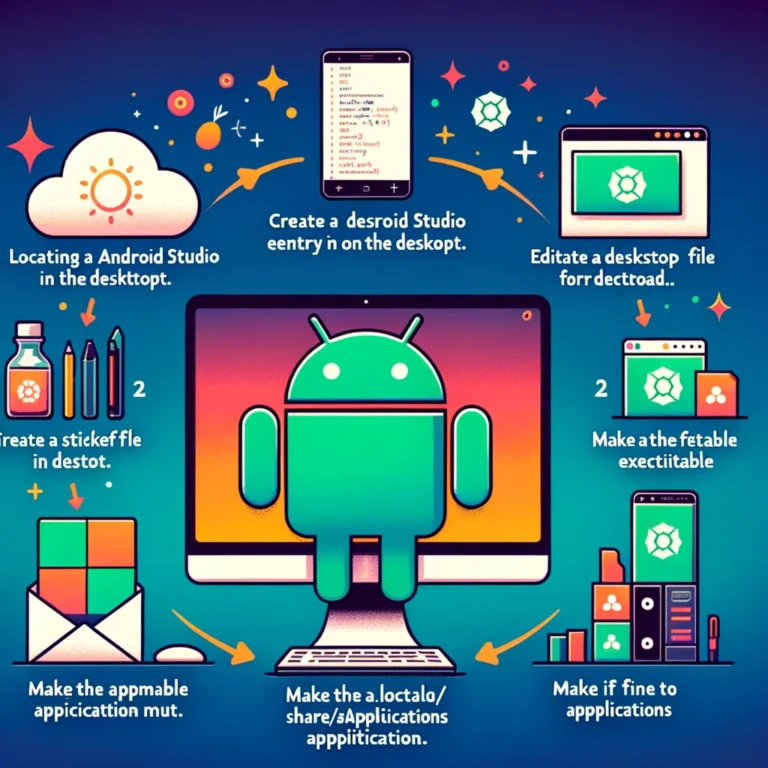Location Based Alarm Android Project
Location Based Alarm Android Project: A Step-by-Step Guide for Developers
The world within our digital devices is rife with innovation, where the very concept of time and space has been reconceptualized. Among the various incredible applications that you can develop, geolocation-based projects are always a standout, providing a unique blend of practicality and technical challenge. In this extensive guide, designed for burgeoning Android developers, I’ll take you through the process of creating a location-based alarm system. We won’t just skim the surface; instead, we will immerse ourselves in the development workflow, ensuring you not only understand the technical implementation but also how to create a robust, user-intuitive application.
What is a Location-Based Alarm Android Project?
A location-based alarm is an app that lets users set an alert that gets triggered when the user arrives at a specific geographical position. The applications of such a feature are numerous – from reminding you to pick up groceries as you pass by a store to waking you up as you reach your station in public transport. The project we’re about to build is known as ‘MapAlarmist’, a fully functional and open-sourced location-based alarm application for Android devices.
But more than just an alarm, this project is a canvas for learning valuable development skills; it incorporates numerous Android development concepts, including location services, user interface design, background services, and more. By the time you finish this guide, you’ll have built a working app that is not just a copy-paste job from a tutorial but a product of your growing skillset as a developer.
Understanding the Structure of the Project
Before we roll up our sleeves and start coding, it’s crucial to understand the structure of the project we are about to build. This conceptual understanding is the foundation upon which we will erect the framework of our location-based alarm system.
The MapAlarmist project consists of several key components:
- Permissions Management: Our app will need to request permissions from users to access their device’s location. We’ll ensure the process is smooth and secure.
- User Interface (UI): A layout that’s intuitive and appealing, allowing users to add alarms, manage their settings, and more.
- Location Services: The core of any geolocation project. This service will interact with the user’s GPS to determine current position and calculate distance to set locations.
- Persistence and Data Handling: We won’t forget the alarms, right? Saving the user’s alarms and settings securely is a priority.
- Background Service: Our alarms can’t just sound when the app is open. We need a background service to handle this functionality reliably.
- Scheduling and Triggering Alarms: Efficiently scheduling when an alarm should go off and managing that process without taxing the device’s resources is an art in itself.
- Notifications: When it’s time for the alarm to go off, we’ll notify the user, even if the app is in the background.
With that overview in mind, it’s time to break down these components and start piecing together the MapAlarmist app.
Setting Up the Project
The first step in any development process is to set up your environment. For this project, we’ll use Android Studio, the official Integrated Development Environment (IDE) for Android application development.
Environment Pre-Requisites
- Android Studio: If you don’t have it, download and install Android Studio – it’s free and comes with everything you need to build Android apps.
- Android Device or an emulator: You’ll need a device to test your app or use the built-in emulators.
Creating a New Android Project in Android Studio
- Open Android Studio, click ‘Start a new Android Studio project’, and follow the creation wizard.
- Choose ‘Empty Activity’ as the template.
- Name your app ‘MapAlarmist’, select ‘Kotlin’ as the language, and choose the lowest API level you’re comfortable supporting.
- Follow through the wizard to create your project.
With a project set up, you’re ready to tackle the next steps.
Designing the User Interface
A well-designed user interface is crucial for any app, ensuring that it’s not only functional but also intuitive and delightful to use.
Creating the UI Layout
We will start by crafting the screens and individual views that users will interact with. We will use XML to define our layouts.
Open your `activity_main.xml` (or equivalent) file, and define what the main screen of your app should look like. Use the following as a basis:
<RelativeLayout xmlns:android="http://schemas.android.com/apk/res/android"
xmlns:tools="http://schemas.android.com/tools"
android:layout_width="match_parent"
android:layout_height="match_parent"
tools:context=".MainActivity">
<TextView
android:layout_width="wrap_content"
android:layout_height="wrap_content"
android:text="Map Alarmist"
android:textSize="24sp"
android:id="@+id/title"/>
<Button
android:layout_width="wrap_content"
android:layout_height="wrap_content"
android:text="Set Alarm"
android:id="@+id/setAlarm"/>
</RelativeLayout>
This very basic UI has a title and a button. Your UI will expand to include more complex elements such as lists of alarms, detailed views, and more.
Adding Functionality to the UI
Once your elements are in place, you’ll need to link them with the business logic of your app. This is done by referencing them in your activity class (e.g., `MainActivity.kt`) and implementing behavior using listeners or data binding.
Update the `MainActivity.kt` to include behavior for the ‘Set Alarm’ button:
class MainActivity : AppCompatActivity() {
override fun onCreate(savedInstanceState: Bundle?) {
super.onCreate(savedInstanceState)
setContentView(R.layout.activity_main)
val setAlarmButton = findViewById<Button>(R.id.setAlarm)
setAlarmButton.setOnClickListener {
// Open the activity to set the alarm
startActivity(Intent(this, SetAlarmActivity::class.java))
}
}
}
Crafting the Set Alarm Activity
The ‘Set Alarm’ button leads to an activity where the user can specify alarm details such as the location and label. Create a new activity, `SetAlarmActivity`, and design its layout.
Remember to use `EditText` for entering the label, a `MapView` for selecting the location, and a `Switch` or `ToggleButton` for enabling/disabling the alarm.
Location Services and Permissions
Location services can be a complex part of any Android app. For MapAlarm, we’ll use the Fused Location Provider API to get the device’s location. Additionally, we’ll manage permissions with the new AndroidX libraries.
Requesting Location Permissions
In your `MainActivity.kt`, include the logic to request permission for location access. Use the `checkSelfPermission` method to find out if you have permission and the `requestPermissions` method to ask for it if necessary.
class MainActivity : AppCompatActivity() {
// ...
companion object {
private const val LOCATION_PERMISSION_REQUEST_CODE = 1
}
override fun onCreate(savedInstanceState: Bundle?) {
// ...
val setAlarmButton = findViewById<Button>(R.id.setAlarm)
setAlarmButton.setOnClickListener {
if (hasLocationPermission()) {
// Open the activity to set the alarm
startActivity(Intent(this, SetAlarmActivity::class.java))
} else {
requestPermissions(
arrayOf(Manifest.permission.ACCESS_FINE_LOCATION),
LOCATION_PERMISSION_REQUEST_CODE
)
}
}
}
private fun hasLocationPermission(): Boolean {
return ActivityCompat.checkSelfPermission(
this,
Manifest.permission.ACCESS_FINE_LOCATION
) == PackageManager.PERMISSION_GRANTED
}
}
Getting the Device’s Location
Use the `FusedLocationProviderClient` and its `getLastLocation` method to acquire the device’s coordinates. Note that getting the location is an asynchronous process and should be handled as such.
class SetAlarmActivity : AppCompatActivity() {
private lateinit var fusedLocationClient: FusedLocationProviderClient
// ...
override fun onCreate(savedInstanceState: Bundle?) {
// ...
fusedLocationClient = LocationServices.getFusedLocationProviderClient(this)
// Get location when the user enters the Set Alarm screen
// This is just an example, you would trigger this based on user action
fusedLocationClient.lastLocation.addOnSuccessListener { location: Location? ->
// Logic to handle the location retrieval
if (location != null) {
// Use the location to do something
}
}
}
}
Data Persistence and Alarms
The alarms users set need to persist beyond the life of the app. For MapAlarmist, we’ll use Room, a SQLite object mapping library included in Android Architecture Components, to save alarms to a local database.
Setting Up Room
To use Room, you’ll need to add the dependency in your `build.gradle`:
implementation "androidx.room:room-runtime:$room_version"
kapt "androidx.room:room-compiler:$room_version"
You’ll also need the Kotlin annotation processor plugin. Make sure you add these in the `build.gradle` of your app-level project:
apply plugin: 'kotlin-kapt'
dependencies {
// ...
kapt "androidx.room:room-compiler:$room_version"
// ...
}
Creating the Alarm Entity
Define the structure of the alarm in a Room `@Entity` annotated class.
@Entity(tableName = "alarms")
data class Alarm(
@PrimaryKey(autoGenerate = true)
val id: Long,
val label: String,
val latitude: Double,
val longitude: Double,
val isEnabled: Boolean
)
Building the Room Database
Create an abstract class that extends `RoomDatabase` to be the database holder, and include the definition of the entities and the database version.
Defining the Data Access Object (DAO)
A DAO is responsible for defining all of the methods you use to interact with your database. Annotate a DAO interface with `@Dao`.
@Dao
interface AlarmDao {
@Insert(onConflict = OnConflictStrategy.REPLACE)
suspend fun insert(alarm: Alarm)
@Update
suspend fun update(alarm: Alarm)
@Delete
suspend fun delete(alarm: Alarm)
@Query("SELECT * FROM alarms ORDER BY id ASC")
fun getAlarms(): LiveData<List<Alarm>>
}
Using the Repository Pattern
Create a `Repository` class to manage multiple data sources (e.g., a Room database and a network service).
class AlarmRepository(private val alarmDao: AlarmDao) {
val allAlarms: LiveData<List<Alarm>> = alarmDao.getAlarms()
suspend fun insert(alarm: Alarm) {
alarmDao.insert(alarm)
}
}
Tying it all Together
In your `SetAlarmActivity`, save the alarm when the user specifies it. You’ll also need to create an AlarmsListActivity to display all saved alarms.
Remember to use Kotlin Coroutines or any asynchronous pattern you’re comfortable with to carry out database operations. They should never be executed on the main thread.
Background Services and Notifications
For our location-based alarm, we need the alarm to sound even if the app is not in the foreground. To handle this, we must create a background service that listens and triggers the alarm based on the user’s distance from the location set.
Starting the Service
Use `startService` to start the service. Make sure you handle the appropriate service lifecycle methods such as `onStartCommand`, `onCreate`, and `onDestroy`.
class MyService : Service() {
override fun onStartCommand(intent: Intent?, flags: Int, startId: Int): Int {
// ...
}
}
Creating a Notification
When the alarm goes off, trigger a notification to alert the user. Use the `NotificationCompat.Builder` class to create a notification.
val notificationManager = ContextCompat.getSystemService(
this,
NotificationManager::class.java
) as NotificationManager
val builder = NotificationCompat.Builder(this, "channelId")
.setSmallIcon(R.drawable.notification_icon)
.setContentTitle("Alarm triggered at designated location")
.setContentText("You have arrived at your destination")
.setPriority(NotificationCompat.PRIORITY_DEFAULT)
notificationManager.notify(1, builder.build())
The `channelId` is used to create the notification channel if not already created. You should create this channel in your service’s `onCreate` method.
Tying it to Alarms
When you save an alarm, also set up the background service to watch for the destination. Trigger the alarm based on proximity to the set coordinates.
Scheduling and Cancelling Alarms
You shouldn’t be polling the location service constantly; it’s a huge battery drain. Instead, you should schedule alarms to fire at an expected time or when the user’s coordinates come within a certain distance of the set location.
Scheduling Repeating Alarms
Use `AlarmManager` to schedule repetitive alarms. An important detail is that the `PendingIntent` you pass to `AlarmManager` should be one that starts a Service or a BroadcastReceiver, not an Activity.
val intent = Intent(context, MyService::class.java)
val pendingIntent = PendingIntent.getService(context, REQUEST_CODE, intent, 0)
val alarmManager = context.getSystemService(Context.ALARM_SERVICE) as AlarmManager
alarmManager.setRepeating(
AlarmManager.RTC_WAKEUP,
triggerTime,
AlarmManager.INTERVAL_FIFTEEN_MINUTES,
pendingIntent
)
Cancelling Alarms
When the user deletes an alarm, or it becomes irrelevant, be sure to cancel the scheduled event.
val pendingIntent = PendingIntent.getService(context, REQUEST_CODE, intent, 0)
val alarmManager = context.getSystemService(Context.ALARM_SERVICE) as AlarmManager
alarmManager.cancel(pendingIntent)
Remember that `REQUEST_CODE` should be unique for each alarm being scheduled or canceled.
Testing and Debugging
A project with so many moving parts is ripe for bugs. When testing, make use of Android’s extensive testing libraries, including JUnit, Espresso, and Mockito.
Unit Testing
Write unit tests to validate the behavior of individual classes and methods.
Integration Testing
Test how different parts of the app work together with integration tests to verify that individual units are functioning as expected when combined.
UI Testing
Ensure your UI works as expected with UI tests. Android Studio’s Espresso Test Recorder can help you create tests based on your use of the app.
Debugging
Use Android Studio’s built-in debugging tools to inspect and solve problems in your code. Set breakpoints, step through your code, and check variable values to see what’s happening under the hood.
Deployment
Once everything is in working order, it’s time to deploy your app. Sign your APK or bundle, and submit it to the Play Store.
Preparing for Deployment
Create suitable graphic assets, write a compelling description, and ensure you app passes all of Google’s quality checks before submission.
Releasing to the Play Store
Submit your app for review, and once approved, release it to the Play Store.
Advanced Features and Customizations
If you’re looking to take this project even further, there are numerous customizations and feature extensions you can explore.
Geofencing
Geofencing allows you to define virtual boundaries around real-world geographic areas. When a user enters or exits these boundaries, your app can trigger an event.
Custom Alarm Sounds
Give users the ability to set their own alarm sounds. This is especially useful for accessibility or preference reasons.
Customizable Proximity
Allowing users to set the range at which they want to be alerted gives a more personalized touch. It also gives the user a better understanding of the system’s sensitivity and can help conserve battery life.
FAQs
Can I import this project into Android Studio if I want to follow along without creating it from scratch?
Yes, this project is open-source and available on Link.
Is it possible to port this project as an iOS app using Swift or Objective-C?
Absolutely. While the specifics of implementation will differ, the core concepts can easily be translated. Apple’s Core Location framework is the equivalent of Android’s location services.
Would this project be suitable for larger scale use, or is it more for educational purposes?
This project is a great starting point for educational use or as a prototype. For larger scale use, especially in a production environment, you would need to consider many additional factors such as security, battery optimization, network usage, and more.
Conclusion
Building a location-based alarm Android project, such as MapAlarmist, is a challenging but rewarding endeavor for any Android developer. This guide has taken you through the entire life cycle of development, from project setup and UI design to dealing with permissions, background services, and database persistence. You’ve also learned about important considerations like testing, debugging, and deployment.
By following this detailed guide, developers can create more than just a functional alarm app; it serves as a huge learning experience. The skills you’ve honed along the way are not just applicable to this specific project but form a foundation for more complex and innovative applications in the future. And with the project being open source, the possibilities for customization and enhancement are endless.









Thanks for sharing. I read many of your blog posts, cool, your blog is very good.
thanks for your appreciation